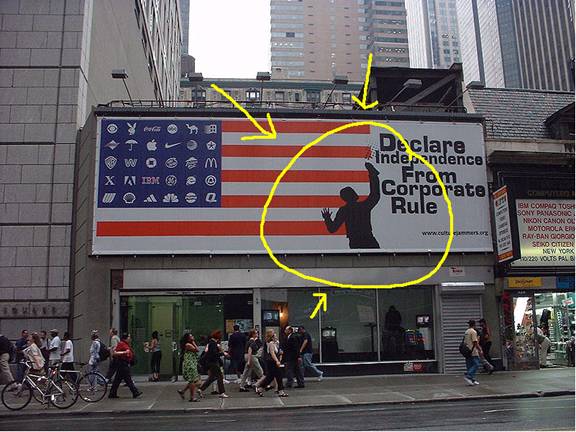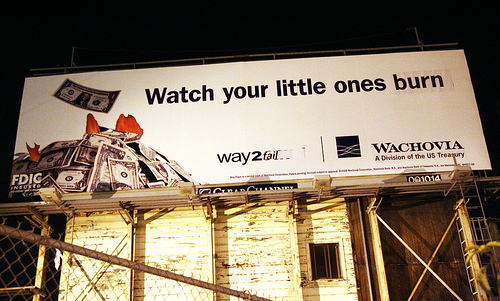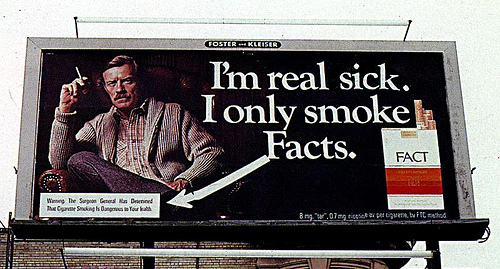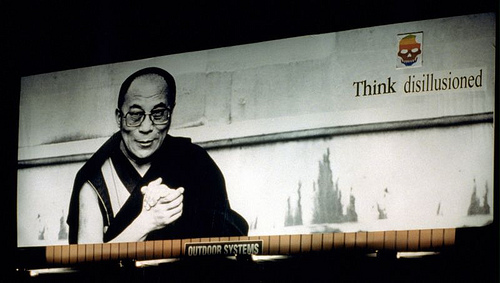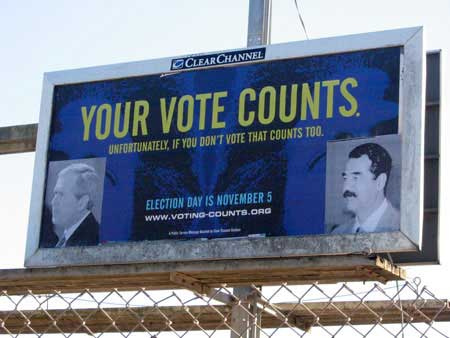Jack Napier: The Billboard Liberation Front (Interviews)
Interview with Jack Napier
JN: We collaborated with Ron English, who came in from the east coast, to help celebrate the fiftieth anniversary of McDonalds. After some reflection, we realized that McDonaldıs ultimate goal was 'to serve man.' We decided to do our part by putting up a billboard close to one of the highest-volume McDonalds retail stores in San Francisco.
People dressed up as 'Ronald McDonald' and showed up for our billboard 'christening.' Ron painted a backdrop of a fat, sardonic Ronald McDonald on the left, a giant alien on the right, a McDonaldıs gateway arch in the middle, plus a caption, 'To Serve Man.' In the center we put a life-sized, live-action animatronic Ronald McDonald with a giant Big Mac in his hand, perpetually pushing it into the face of a corpulent eight-year-old kid kneeling in front, like he was taking Communion. There was a live-action tableau on the platform in front, with the billboard painting behind it.
Our press release reflected the fact that weıre supporting McDonalds in their 50-year effort to fatten up humanity, to better serve them to the aliens that are coming down!
V: Where do you get Ronald McDonald outfits?
JN: You can get a cheap red wig at a costume store. [Ed. note: Ron English and his wife Tarssa made Ronald costumes; BLF associates made their own, as well as three compelling 'Hamburglars!'] Then you need white leggings and a red-and-yellow striped shirt. Our website might list stores where you can get these. I pre-wired the billboard, so all we had to do was put the dummy on a pre-set stand, plug him in, and he started punching the kid in the face with the hamburger.
V: What an idea--
JN: This was inspired by an old 'Twilight Zone' episode, 'To Serve Man,' [Episode 89] where these happy, friendly, aliens arrive on earth and start helping humanity. They have a book theyıre reading, and a suspicious woman steals a copy and starts translating it. She finds out, to her horror, that itıs actually a cookbook! This McDonalds hit was in the middle of the day, on a Sunday afternoon--Memorial Day, actually--near Golden Gate Park. There were a million people in the street, cops driving around, bicycles and cars constantly going by. We had a van with Viacom stickers on the sides (which is the company that owns the billboard). Four of us were working on the board, and until we put up the animatronic figures, nobody looked askew at us. Our ground crew was watching to see if anybody was suspicious, and if it looked like they were getting on a cell phone to call the cops, theyıd try and stop them.
The hit was in a Cala Foods parking lot, and one of our spotters was inside the store. He overheard one person go, 'Hey, do you think thatıs an ad for that movie Supersize Me?' He automatically thought it was a legitimate image, even though it was the most bizarre image you could conceive of. As a distraction, we also had about thirty people dressed up as Ronald McDonald--their job was to show up at the last minute and take away attention from us when we were finishing up the billboard.
So we finished, got into our van and escaped a few blocks away. We parked, put on our Ronald McDonald costumes and returned to join the crowd of other Ronald McDonalds. By this time the police had come; the CALA Foods manager had called ıem. The police showed up and couldnıt do anything about the billboard. The Fire Department came later and took down the two manikins. But theyıd already been up for several hours, and weıd filmed the whole thing. Then the police put the manikins in a paddy wagon, but they couldnıt close the rear doors, so their feet stuck out.
Basically, the cops came, arrested Ronald McDonald, threw him in a paddy wagon, we filmed this and it became part of the feature film Popaganda, a film documentary about Ron English--the finale of which is the BLF and Ron English doing this billboard hit. It couldnıt have worked out more beautifully--the cops arresting Ronald McDonald was beautiful! For my money, this was the greatest billboard hit I ever heard of, because it was the only one that used live animatronic figures; the only one where we had an entire street theater piece using thirty Ronald McDonalds on the ground, and the police who showed up were part of the event. And we left a good bottle of Scotch on this Ronald McDonald billboard for the sign workers.
Now for me, the best pranks are whimsical and humorous. You could spray-paint 'Fuck McDonalds' on a billboard, and people who are already Greenpeace or Adbusters or anti-globalist types will nod their heads in agreement. But thatıs like preaching to the choir. Itıs the people who donıt necessarily think that way that I want to get to. I like it when people pause and look, especially if itıs confusing. Thereıll be that second when theyıre thinking, 'What the hell does that mean?' . . . a little glitch that makes people think about where they are, and question what advertising really is.
There is a ubiquitous, non-stop barrage of corporate advertising and imagery everywhere we go, and we need to yell back at ıem! There are many groups around the country who alter billboards, and weıre all just telling people, 'Advertising is a language. Youıre being spoken to constantly through these ads. But you can talk back to them! You can make it a dialogue. And you donıt necessarily have to climb on up and alter a billboard. So every time you see a Nike swoosh logo, in your mind you can change it to a dildo or something you find humorous.' So in our billboard alterations, weıre simply having a dialogue with the advertisers...
***
A friendly public service announcement from the Billboard Liberation Front
Article by Brian Gonnella
…so I have this theory:
Graffiti art and commercial advertising are like mongooses and cobra snakes.
Two vicious adversaries fighting over wall-space in the great metropolitan hubs of the world. And I think it’s safe to say that the snakes are winning.
So I was doing a little strategizing, hittin’ up wikipedia like it owed me money, and I came across the page for this phenomena known as “culture-jamming”. Apparently there’s this “movement” (1) out there that actually encourages “turning away from all forms of herd mentality” and that it “could be defined as an art movement” and “public activism”—which to me sounds like graffiti. So I checked out the page for “the flagship publication for the culture jamming movement” and sure enough:
That’s a cartoon-graffiti-writer-logo-thing on an Adbuster’s billboard. These people are associating themselves with graffiti culture so apparently our missions are likeminded. So needless to say I wanted to know more about this “movement” I was missing out on because I don’t like herd mentality either. I scrolled through the “List of culture jamming organizations or people” and reading through it I saw one I recognized from lurking on graffiti websites past: The Billboard Liberation Front.
Asides from having a badass operating title, the BLF has claimed responsibility for “improving” advertisements since 1977. According to wikipedia they accomplish this improvement “by changing key words to radically alter the message, often to an anti-corporate message” which, if you consider the work, seems logical…
But I wanted to know more. What is it that these people are doing? What do they want? What are they trying to say? And what do they want with graffiti?
So I got on the horn and got connected with Jack Napier (2), one of the chief guilty-parties at the organization to ask the man behind this a few questions:
Bombing Science: First things first, I have to know…the name: Jack Napier…an allusion to the Joker? Or just a coincidence?
Napier: There is no such thing as coincidence, only opportunity tempered by experience and fueled by ambition.
BS: Tell us about this Culture-Jamming thing.
Napier: The “Culture Jamming tm” is more in the domain of Adbusters than the BLF. We really don’t feel like it’s necessary to be part of a “movement” other than the requisite daily bowel movements. Unlike Adbusters and despite the fact that we promote our work as “advertising” we have neglected over the last 32 years to actually design, fabricate, market and sell a product! Silly us. Our confrere’s to the north not only have created a fairly complex business model that has been extremely efficient at marketing their trademarked schwaag, they have accomplished this not small task while marketing “non-marketing” type products.
They only miss out on sales potential one day a year—the aptly named “Buy Nothing Day.” They amply make up for this down time in product sales the other 364 days of the year as do all other nationally and internationally known brands. This jiu jitsu marketing maneuver which targets a very specific but well heeled youthful protest market has been successfully used by others in the “Culture Jamming” business community. This demographic is also profitably mined by such brand as American Spirit Cigarettes, The Daily Show, Tom & Jerry’s Ice Cream, Burning Man, “Organic” of “Green” anything. Prominently among the (not necessarily self defined) “culture-jamming” crowd, we would place Shepard Fairey and our dear friend Ron English in this category. Shepard and Ron richly deserve to make a living off their brilliant work. They are actual artists as opposed to mere marketers like the BLF and Adbusters. They have also paid their “street dues” through numerous arrests and beatings by the cops. We don’t begrudge them their financial success. We applaud it. Adbusters, however, seems intent on completely cornering the market on “Culture Jamming” products and we view their ultimate goals with more than a little suspicion. Sorry to seem so cynical, but after all we’re in advertising!
…It was at this point that I realized I’d been dooped. There was more validity to Mr. Napier’s statement than even he realized. The Adbuster’s billboard had effectively reached me as a consumer of their product. Because of their inclusion of a graffiti writer in an advertisement, I somehow related it to my lifestyle and kept on reading about it instead of just drifting off after a while and looking at porn.
BS: So does graffiti have a role in “Culture Jamming TM”? Or regular “Culture Jamming” even”?
Napier: Some street artists are brilliant and their work should be seen by all. The worst taggers are those who mark their territory with ugly scrawls and should be beaten as reward for making the world an uglier place. Those artists who speak to a target demographic with powerful imagery that spreads the fame of their mark should benefit from their talent and industry (See comment on Ron & Shepard above.) If their work seems political in nature it will probably be lumped in with “Culture-Jamming TM” and should broaden their customer base should they make the move from the alleys to the galleries.
So apparently I was wrong—which really isn’t all that surprising. But still, there has to be a reason why graffiti is being associated with this movement. It isn’t just Adbusters. If you go look at the “List of culture-jamming organizations and people” you would see things like Banksy and Andre the Giant has a Posse and something called the Graffiti Research Lab. It could be just coincidence but apparently there’s no such thing. “only opportunity tempered by experience and fueled by ambition.”
BS: So then what is it about what you do that keeps you doing it? Is it a mission? A sense of duty? Your worldly dharma perhaps? Where did it all begin?
Napier: When I was 18 years old, I have the great good fortune to be allowed to join a truly underground group, The San Francisco Suicide Club. To date this short lived (5 years) cabal is the only thing I’ve ever been aware of or involved in that simply never compromised on it’s original intent and mission. My first billboard was with the Suicide Club:
And I was so inspired by this experience that, along with Irving Glikk and Simon Wagstaff, I started the BLF. When the BLF did our first board(s) on Christmas day 1977:
Simon introduced me to the power of advertising through the press release. Our little action in SF was picked up by the wire services and hit newspapers and magazines around the world. The hit was also covered by local TV. My 19 year old juvenile delinquent mind and ego went spinning off into realms of possibility that made me giddy with glee and the promise of clandestine adventure that has carried through to this day. I had learned at that precious age the power of communicating through advertising. Not once since that day have I even been sold to (with out accepting the sale- I actually like some products, like f’rinstance good scotch, soft toilet paper, quality pornography, etc) by any marketer without understanding the exchange and participating in it completely of my own free will.
I remember some years back kids in the ghetto were supposedly killing one another for their Nike and Adidas shoes. If those kids, many of them just as smart & motivated as I was at their age, really understood the products and more importantly the marketing schemes behind them, they wouldn’t be scragging one another for a pair of dumb shoes—they might try and find out where Phil Knight lives and beat him to death with swiping his wing tips though.
Clandestine adventure!? A rally against brand identity!? These certainly sound some of the essential pillars of graffito. I mean, if you break it down spiritually graffiti was born out of a civil strife against the same things the BLF seems to be combating…but every movement has standards and limitations. I needed to know how far deep into the machine these people were willing to go.
BS: What aspects of our society would you call off-limits? And if the goal of the “culture-jammer” is to evoke and engage active thought within the general public, is there such a thing as a line to cross?
Napier: I can only speak to “Outdoor Advertising” since that is our field of expertise. When we at the BLF say that we love billboards, we’re not kidding. The landscape of a thriving urban center should be filled with loud, discordant sound and imagery. In such a caldron, new thought and endeavor, through striving, competition and innovation is not only possible, it is inevitable. Billboards are one type of advertising communication that is unavoidable. Hence, we believe that these giant statement which occupy our shard landscape is fair game for anyone to utilize. (3) The more signs, the better. We just take issue with the dumb messages most of them promote. A campaign like Apple’s “Think Different” series in the late 90s provided the public with many beautiful images.
It’s just that they were selling their silly products (which I use by the way—same as you.) with images of Dead People.™ We had no choice but to rectify this unseemly situation. When it comes to public service billboards, or cute kitty billboards or Mother Theresa billboards, we see them as fair targets as well.
BS: Ok, so imagine if we all wake up tomorrow and there’s no more corporations, no more globalization, colonialism, rouge states and crooked politics….does the BLF’s brand of “Culture-Jamming” still exist?
Napier: Unfortunately, there will such a world. Corporations might disappear one day, but they will be supplanted by some other for of oppressive control.
At the heart of Western culture—OUR Culture, is the myth of the rugged individual adhering to a singular and personal code of ethics that, despite outside influences, coercion, group think, etc, etc., will survive and thrive, sustaining the spirit of the righteous loner who chooses his associations and makes his way boldly through a corrupt and obsequious world. You know, John Wayne, Ayn Rand, blah blah blah. Well, as silly as this may all seem to any college educated, post-modern, deconstructed “zen” practitioner, it really is true. It’s what made the United States, despite ALL of the well documented egregious miscalculations and mistakes we’ve made, the greatest most beneficent, open, inclusive and grand culture in history. The old aphorism “democracy is the worst form of government…except ALL the others..” rings true. It’s what we’ve got and we have to work with it. The road to Hell is paved with good intentions. State Socialism collapsed in upon itself inevitably. Let’s hope our “pioneer spirit” helps prod the evolving Trans National Global Industrial Plutocracy into the same pit that the Commies fell into. Then we can get back to business as usual: individuals and small business interacting with one another out of choice as well as necessity driven by self interested tempered with community need.
A kid with a crayon writing his own response to a multi-million dollar ad campaign can only be seen as part of the grand history of INDIVIDUAL THOUGHT and the messy yet mandatory democratic ideal.
…The BLF can certainly be seen as an extension of that same pioneer spirit. The archives on their website and various flickr.com galleries provide good insight on exactly what these rugged individuals seem to be crusading against. All the big dicks are being aptly dicked back:
The Religious Right
The Government!
And of course, Wall-Street and Big Business.
But despite all aesthetic jibba-jabba, in virtually all other interviews I’ve found to read—there seems to a thematic vagueness as to where the political allegiances of the BLF truly lie…so I investigated:
BS: I’ve read in a few interviews that you don’t consider your art to have any politics…how can you justify that statement in view of the tone and subject matter of the body of work you’ve completed with the last 8 years?
Napier: Made you curious didn’t it?
We don’t consider what we do to be “Art” either, by the way.
BS: So with this no logo policy—the non-political, non-art, self-proclaimed “advertising without the products” etc—is the BLF just functioning as “counter-advertising” against whatever? Just running interference with the everyday assumptions and throwing wrenches into the cogs of mundane machine.
Napier: When a young mother fearing that her small, rambunctious children might be shot accidentally, complained to her next door neighbor, Alfred Jarry, about discharging firearms in the backyard of his suburban Parisian house, he brushes aside her concern by stating: should one of the ragamuffins catch a bullet and die that he, Alfred Jarry would effortlessly reconstitute the child through means Pataphysical(4).
I’ve always identified with Mr. Jarry. Nowadays, interest in the history of Gay 90s Parisian alcoholic playwright and hooligan is to be found mostly with young students upon their first encountering stories of his antics and reading his brutal, sketchy, and sometimes quasi-pornographic plays and stories. For some reason, most older folks no longer find Jarry’s self-absorbed shenanigans to be as amusing and they’ve moved on to more serious art and culture models. These models while claiming to lay bare the inner meaning of (?), in point of fact, actually obscure all by explicating themselves in terms that are so intricate, intellectually dense and inscrutable that the average educated layman could never in a million years decipher the holy texts that support and define these epochal art and philosophy theories. (structuralism, post-structuralism, deconstructionism, situationism, etc. ad nausem) The observer, if her merely had the deep wisdom and knowledge of the gatekeepers, the philosophers and intellectuals, then doubtlessly he would understand all, as they do. The massive and ponderous monographs and scholarly works of these impressive philosophies are the domain of the high priests of culture. Much like Alchemists of the past, these scholars hold the keys to the meaning(s) of life (if you believe what they say as the average mideval peasant certainly believed the inscrutable nonsense. Alchemists would propound when discussing the Grail or transmuting base metals to gold or whatever other poppycock they were spinning at the time.)
The Surrealists and Dadaists were of course direct descendents of the thoroughly unexplained antics of Mr. Jarry. The best of them transcribed the images and textures of the increasingly insane world they saw and felt into their own brilliant (and never explicated) painting, text, sculpture and (for lack of a better phrase) public happenings. Some like Breton strove mightily to make sense of it all, in writings (or did he?)
Later the Situationist, ricocheting repeatedly off the one of two sound and newish ideas about symbols that they stumbled onto before and during one big street part in Paris in 1968 (5), would, standing directly on the shoulders of Mr. Jarry, claim to have it all out. I bring them up, because the BLF has for many years now been lumped in with Situationist thought and theory mostly by academics writing about the phenomenon of “Culture Jamming”. But I won’t bore you again with any of my doubtlessly trying opinions on this false movement.
As for the Situationists, be entirely fair, I must say I admire some of the tenants that DeBord and Co. made their reputations on. It’s just that I relate more directly to the childish and possibly inscrutable antics of Jarry. Not only did he never really attempt to lay out his “philosophy” in prose, he didn’t need to. Stories and myths about Jarry, bolstered by the impenetrable CLARITY of his writings and the completely opaque yet airily illuminating philosophy of Pataphysics have insured that his memory and how he both viewed and moved through the world continue to be an inspiration for the young, students and irresponsible old people for years to come.
I will fight to the death to retain a childlike wonder about the world and the inscrutable things that happen in it daily. If, in some way, the BLF is able to spread that feeling, the way of viewing the world to others then we are succeeding in some fashion or other, I suppose.
BS: But your brand of art requires a certain kind of intellectual self-awareness in the person viewing it, given the current state of our vast Americana culture, do you really feel that most people are getting the Joke?
Napier: I feel that presupposing “self-awareness” in any demographic sector is as dangerous as presupposing stupidity or close-mindedness. Is a “hipster” more likely to “get” what we do as opposed to a brick layer? I hope not and I refuse to assume such a notion. The classic failure of soft Marxism in the US and European universities for the last 50 years seems to me to be the simple fact that the academics and intelligentsia invariably know “what’s good for the masses.” They also, despite an ever so small number of them ever having had a real job outsider the warm smushy folds of academia believe they know what the “people” think. Hit me with a two-by-four if I EVER exhibit such arrogance.
…But what about graffiti? I wondered. It too was born out of a culture founded by “pioneering spirits”. In my mind, the two are inexplicably linked. While we use paint and marks to draw on trains, subways, dumpsters, mailboxes and anything else in our way as a means of “liberating” them from the banalities of looking too boring…the BLF challenges the norms of dominant culture by altering billboards in an apparent attempt to create a more interactive world. Both mission statements are seemingly cooperative, emerging at around the same time in our cultural-history. Perhaps one is an extension of the other…
BS: So do you consider liberating billboards as an extension of the graffiti scene and graffiti culture? In the same way graffiti artists “liberate” the sides of trains?
Napier: No. There are a few cross-overs, however. The genius of Shepard Fairey’s work, love him or not, sell-out or not (I personally do not see his work as sellout at all) is the fact that he freely ranges over the various fields of art, graffiti, advertising, pranking and marketing. That’s why he is deservedly famous and successful while pursuing what can be viewed as a rouge, even criminal agenda.
BS: But arguably in the last 10 years, we’ve seen more and more “street artists” make the transition from the “alleys to the galleries” but obviously they had to start somewhere small. Usually as a kid with territory-marking-scribbles that at times aren’t the most visually appealing, but still—would you agree that the world is better off with a little bit of ugly to contrast with that glossed-over façade of commercialism and polished community?
Napier: I never enjoy seeing symbols of hate, stupidity or simple unlettered, thoughtless opinion splattered on the visual scrim that I must view each day. Now, in reality, of course I must deal with an ugly visual landscape. That’s part of our environment. It’s there and unavoidable, yet, you can be selective in what you allow in…It’s the chance juxtaposition of disparate images or essences that I might come across in my daily excursions that give me some hope. Passing a giant image of Amelia Earhart on a billboard gazing out onto the freeway and all comers with an ethereal gaze of such beauty…containing the promise of eternity nor the end of an entire way of life…all only to sell a dumb computer.
But I OWN that image. I took it from the corporation that so cynically appropriated it. The visual wash from that particular image up and off to the moderate impressive skyline of San Francisco was indeed a memorable experience for me. It’s why I love cities. It’s why the L.A. of the movie Blade Runner is my favorite urban creation with Gotham City of Batman (6) and the London of Brazil and the New York City of the 5th Element and the Berlin of Metropolis following as close companions. This is the urban world I wanted to live in. It’s all in your eye and in your mind. Your brain is the ultimate editing device. Use it. The corporations, the government, the religions, your Mom, none of them can occupy and control your mind unless you invite them in…
So I don’t invite the ugly, ignorant images scrawled on walls, to prove a point, to mark territory, or whatever. Why should I? I try and look for the beauty that is there in the most bleak vistas, the most deadening of landscapes.
…or perhaps not. Of course not everyone will agree. I don’t. Graffiti, even in its most crude, simplistic and rudimentary form will still be more appealing visually than a blank concrete slab or that lifeless metallic shimmer of a cargo-freighter. A little bit of color goes a long way. But that being said…a lot of graffiti does not OWN an image or any image for that matter. Not in any lasting, memorable way—hardly can we recall what hastily drawn hand is on the side of what mailbox and where. But some graffiti artists (too many for me to even try to mention) manage to achieve the iconographic everyday.
So back to the question that started this trip down the wikipedia rabbit-hole into the land of BLF: are graffiti and culture-jamming connected?
I think the answer’s yes and no. Or maybe it’s just like the Dao. (7)
Art is art is advertising is graffiti is art. Whatever the medium, whatever the agenda, it’s not our job as artists to take sides (although we certainly can) and it’s not our burden as vandals to create, promote and distribute what society would call ugly or abject (although we still will). The job of the artist, like the job of the “culture-jammer” is to create for the sake of observation and mental interaction—or like Mr. Napier said, to maintain that childlike wonder in the world.
I mean, it really doesn’t sound like a bad idea.
BS: If you found yourself in the position of to control such things, where would you like to see graffiti culture move towards in the next 5 to 10 years?
Napier: Make things of beauty, wonder and mystery. That’s what the best of being human is. If you can’t do that and show others how they might do that, then fuck off and die.
How’s that for a load of major bloviation? You be the judge. If you take me too seriously I’ll think you’re a loser. So there.
Jack Napier: BLF
Chief Bottle Washer
—————————————————————-
1- From this point on I will be interchangeably quoting from wikipedia.com because like Stephen Colbert, I too believe that truth is determined by general consensus.
2- The name Jack Napier should sound familiar to other comic geeks. For those of you that aren’t as trivially inclined, it’s the name of the man who became the Joker aka the Clown Prince of Crime. I figured if any comic book character would spend his time satirically improving billboards it’d be that dude. So I had to ask…
3- see article “graffiti as Marxism”
™To clarify for any nervous Buddhists reading, The Dalai Lama is not dead.
4- “Pataphysics” is a parody of metaphysics, defined by Alfred Jarry as “the science of imaginary solutions, which symbolically attributes the properties of objects, described by their virtuality, to their lineaments"
5- The ’68 Student Revolutions in Paris also gave rise to some of the first graffiti, as we understand it.
6- Pittsburgh!
7- And those who know the Dao, do not speak of the Dao.

